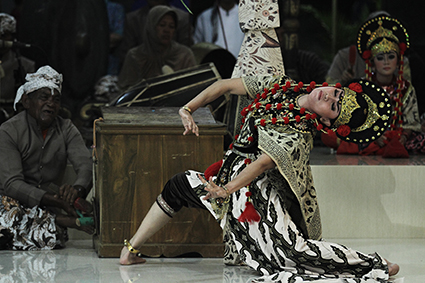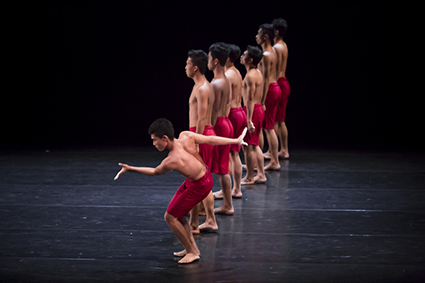The past drives dance into the future
Jane Howard: Dance

Nani Losari, Topeng Cirebon
photo courtesy Ozasia
Nani Losari, Topeng Cirebon
From the darkened space comes a rhythmic stamping, steady and implacable. Slowly, from the black, an eerie white spectre appears, then legs in loose red pants illuminated by a tight spotlight. We see a man, feet pounding, down on the ball of his right foot, then the heel of his left.
Cry Jailolo
In many ways Cry Jailolo, from Indonesian choreographer Eko Supriyanto, is a study in repetition. The work plays off the rigid structure we’re exposed to in the opening moments through the rest of the work, melding elements of militarised marching, stylised fighting and traditional Javanese dancing with contemporary European choreography.
Composer Setyawan Jayantoro also melds influences: a driving electronic score woven through with traditional instruments, but always building from the rhythm of pounding flesh. His soundscape is imbued with the thud of bare feet on the stage and hands clapping slightly off the beat: unexpected rhythms forcing us to focus our attention.
Building the work from this lone man, Supriyanto slowly introduces two more courting each other in a fight, and builds again to seven men working in harmony, endlessly stamping as they track across the stage. Then, he breaks the rhythm: one man peels free, six move in unison; or they all circle and swirl around the stage, splintering out, each expressing their own physicality.
Supriyanto created this work with non-dancers drawn from the community of West Halmahera suffering from the environmental degradation wrought on their island. He works with them to evoke the beauty of a world that is being lost. Bodies swirl to represent the currents and the schools of fish for which these oceans are home.
The performers never appear untrained—they perform with skill and precision–but perhaps because they are, the signs of the physical demands of the work are heightened. They become physically worn by the unrelenting movement and rhythms: leg muscles visibly weakening, sweat shining on their naked chests, exhaustion carving curves in their spines. At one time, they stand in silence, breathing heavily and staring out at the audience. But as the work continues Jayantoro’s music and Supriyanto’s choreography become increasingly frenetic and the dancers’ bodies fall.
With his swirling images of the ocean and of dancers pushed to their limits, Supriyanto builds a physical manifestation of the fight against environmental degradation: endless, exhausting, necessary.
Cry Jailolo
photo Claude Raschella, OzAsia Festival 2015
Cry Jailolo
Play
From choreographers and dancers Sidi Larbi Cherkaoui and Shantala Shivalingappa, the work Play is all in the title: the pair dance the play of childhood exploration; they play their cultural heritages against each other. Musical instruments are played; as is a game of chess. Hands play out a rhythm on a wooden table, projected large above the stage: a vision of music as choreography, the creation of music through play.
It is a slightly uneven work—an extended mask sequence plays too heavily on an outdated sense of humour; a blindfolded dance with an audience member jars. But when the work excels it’s compelling. The key to the passion and complexity of the work is found in Cherkaoui and Shivalingappa’s playing out of their dance vocabularies: contemporary European dance versus classical Kuchipudi from India.
In the moments of contemporary dance both performers are virtuosic, engaging with physical limits and expressing all the possible beauty of their bodies, communicating with each other and with the space they embody. In a solo passage Cherkaoui extends his body into a state of almost incomprehensible looseness: throwing himself around the stage, he extends his legs beyond what seems possible; he arches his back beyond the limits of the spine’s capacity to bend.
But as the pair begins to perform elements derived from Kuchipudi the limitations of Cherkaoui’s training in the form and the intensity of Shivalingappa’s show through. His wrists are never quite held at the right slant; his fingers don’t hold the same tension and power as hers; he never quite achieves the same angularity in the movement of his shoulders and head. This doesn’t diminish our view of his virtuosity; instead, it allows us to fully appreciate hers.
The pair play further with this idea. Hands clasped behind their backs they perform the same rhythmic footwork. Cherkaoui’s feet stamp in heavy black shoes. Shivalingappa’s barefoot soles pound the stage, her toes curling upwards. We see their movements as pure representation of the lineage of Indian dance alongside the European, both manifested here as resolutely modern and born of play.
Topeng Cirebon
While modern Asia was the focus of most of director Joseph Mitchell’s first OzAsia Festival, his curation also reached back to traditional art forms. From the West Javanese city of Cirebon, two dancers and a 17-piece gamelan orchestra presented Topeng Cirebon: a continuing tradition of masked dance performance, dating back 600 years.
With intricately carved wooden masks, performers Nani Losari and Inusi embody traditional characters: playing with ideas of nobility, gender and the devil. They show strength and control as they hold their bodies in squats; they intrigue us as the smoothness of movement in their wrists plays against juddering limbs.
The comfortable seats and LED stage lights of the Dunstan Playhouse feel somewhat at odds with the presentation of this traditional form, and the performance extends for perhaps slightly too long for anyone not knowing topeng and thus unable to pick up the intricacies in shifts between scenes and physicalities. But with only one performance in the festival, Topeng Cirebon is a work firmly aimed at Adelaide’s Indonesian community: an audience invested in this traditional form and excited to see leaders in the craft.
OzAsia’s strength is its focus on both the historical and contemporary art forms it brings to an Australian audience. It’s necessary to see work like Topeng Cirebon to more fully understand the culture of Cry Jailolo and the masks of Play. Still, to Western eyes the passion, power and talent of the region and its artists comes through less when showing us the past than when it is built upon, driving dance into the future.
OzAsia Festival 2015, Cry Jailio, 24-26 Sept; Play, 2-3 Oct; Topeng Cirebon, 26 Sept; Dunstan Playhouse, Adelaide Festival Centre
RealTime issue #130 Dec-Jan 2015 pg. 10






